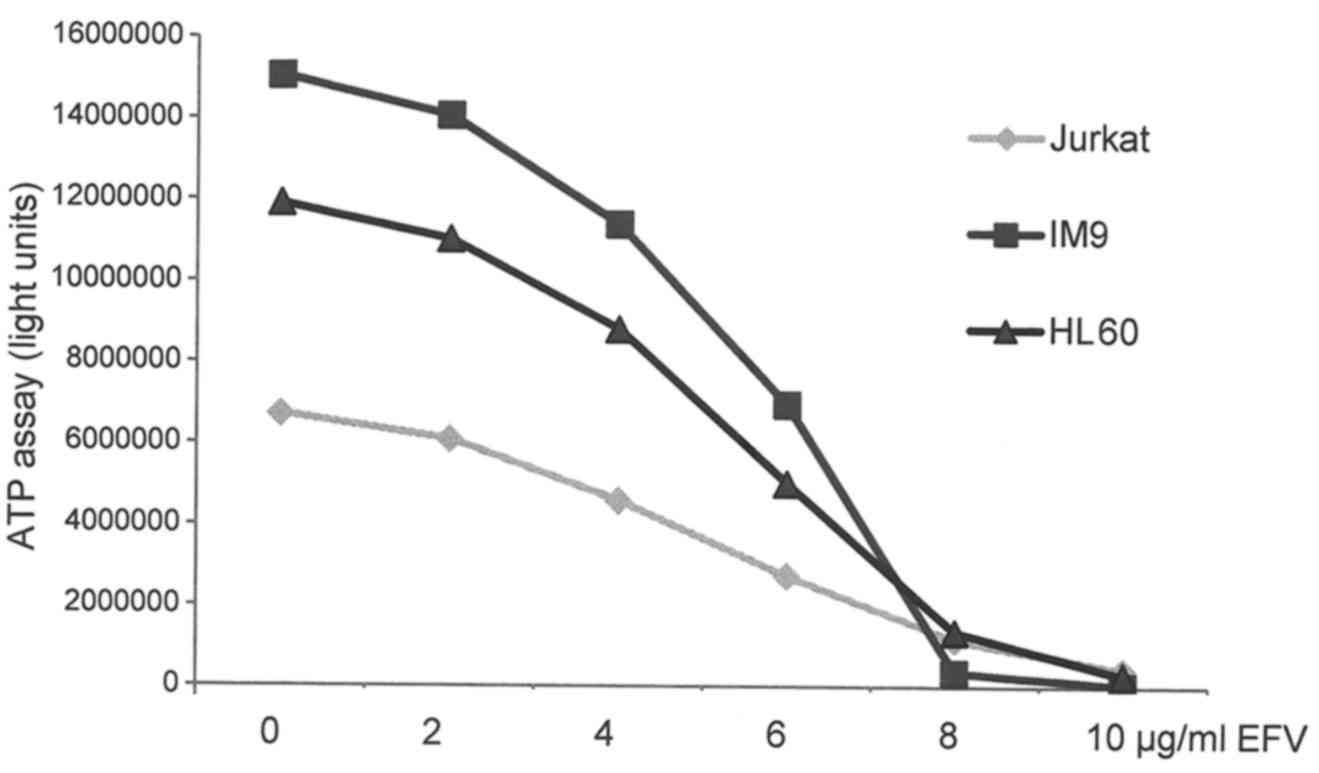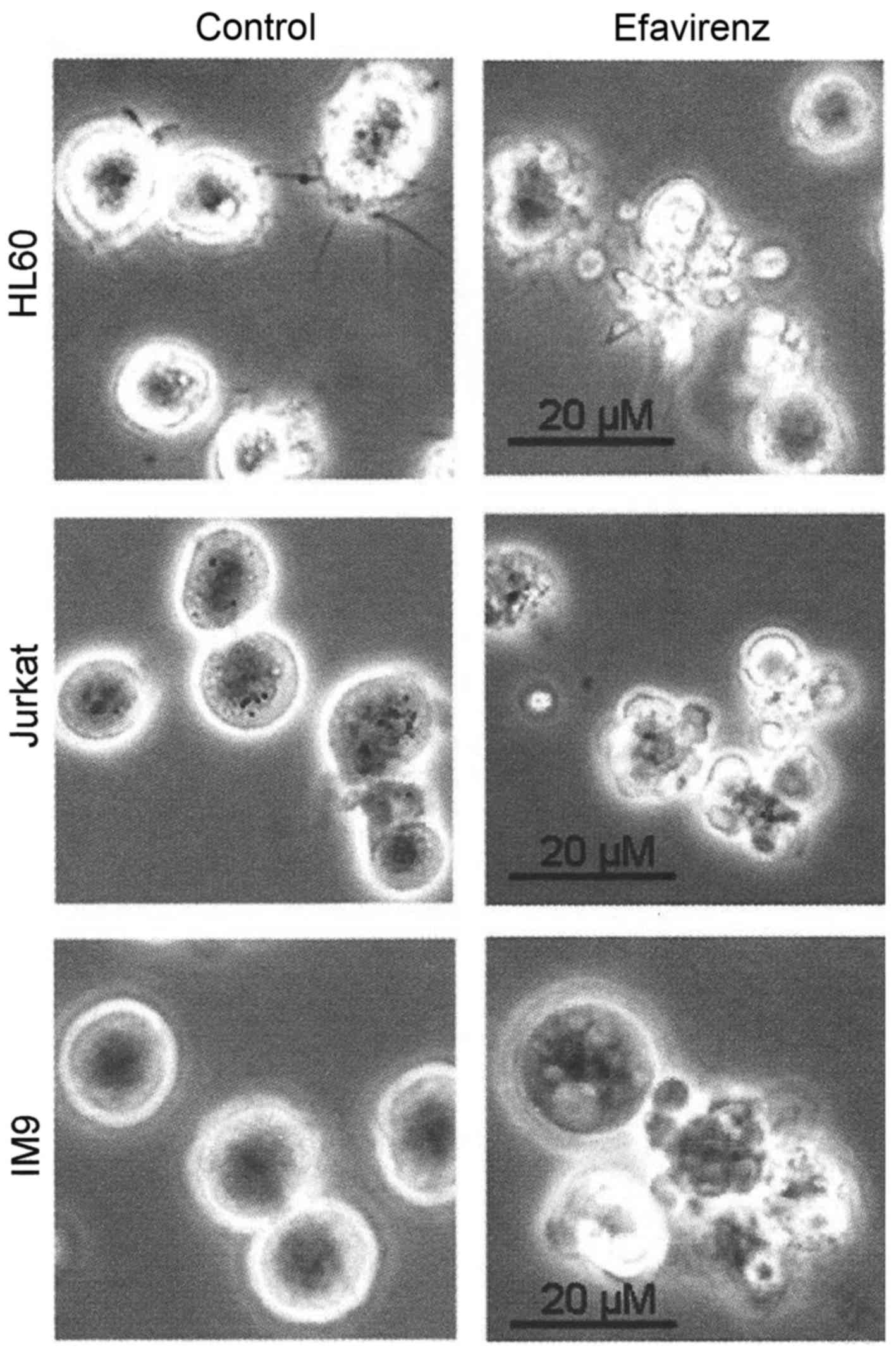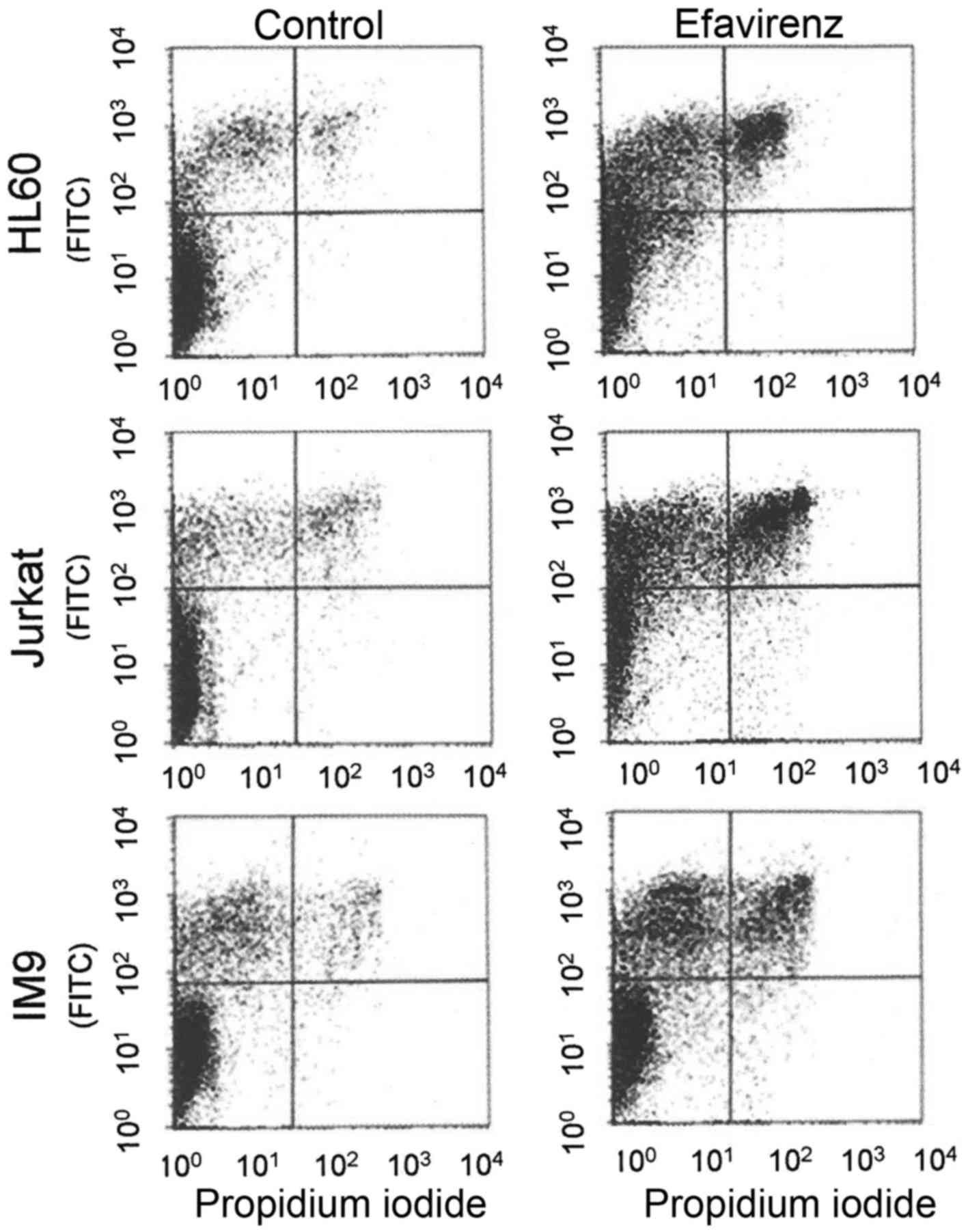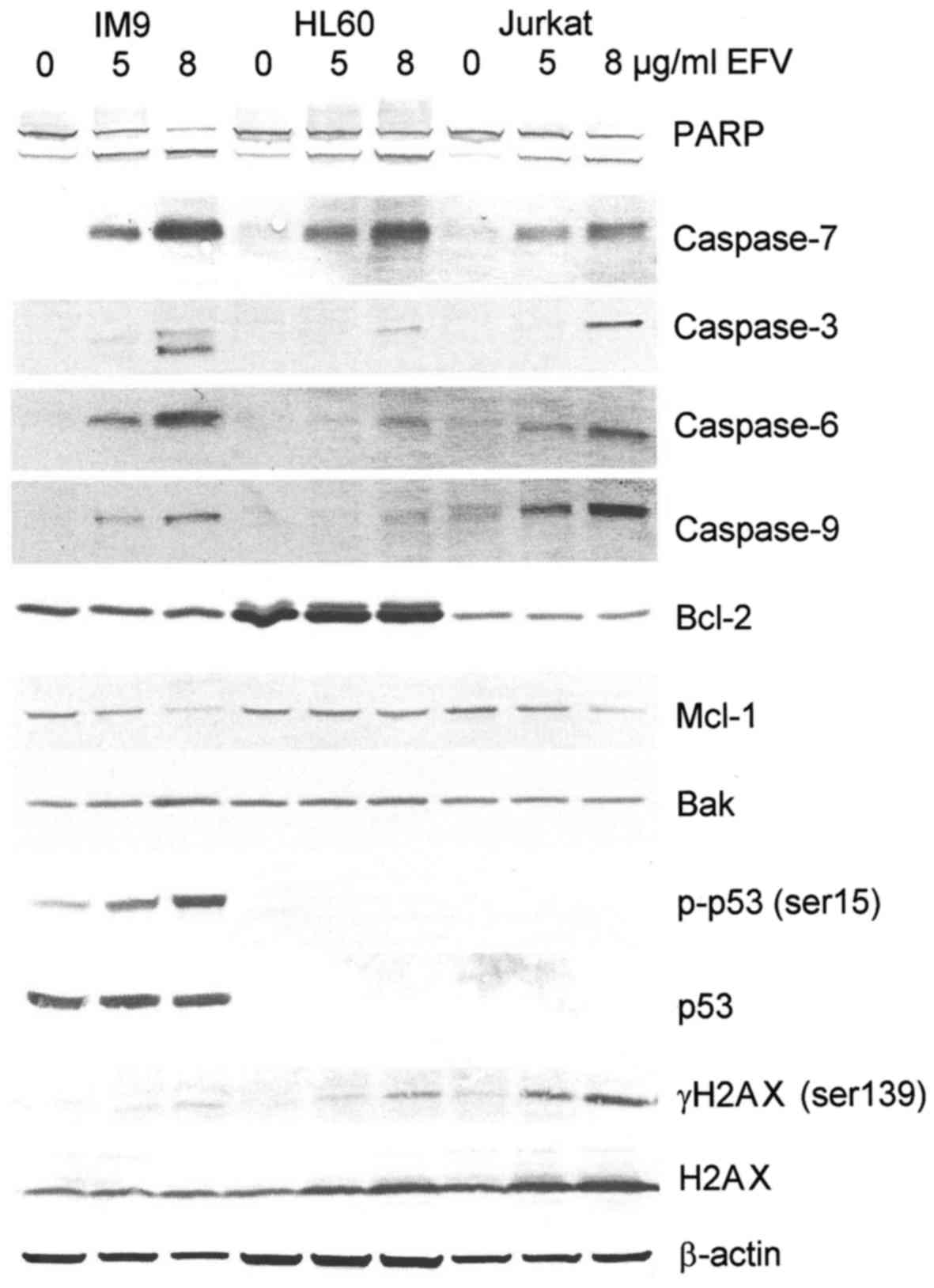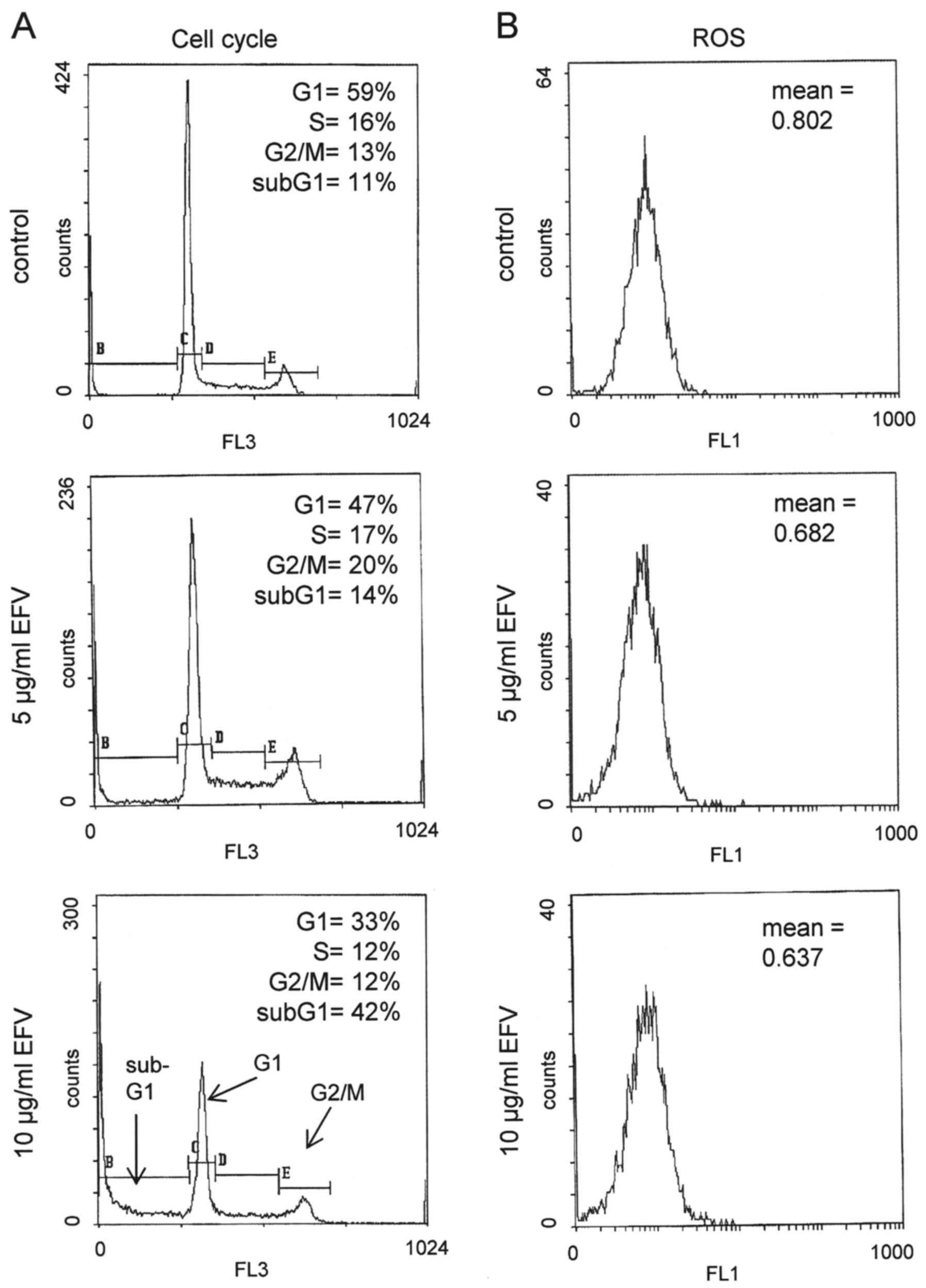Induction of DNA damage and apoptosis in human leukemia cells by efavirenz
- Authors:
- Published online on: November 15, 2016 https://doi.org/10.3892/or.2016.5243
- Pages: 617-621
Abstract
Introduction
The increasing worldwide incidence of cancer is a serious global health problem. Despite significant advances in cancer treatment and drug development, there is an urgent need for additional and better tolerated anticancer drugs to treat primary and recurrent cancers. Unfortunately, the development and discovery of new anticancer drugs is expensive, time-consuming, and in the worst case, must be terminated during clinical trials due to the occurrence of intolerable side effects or poor effectiveness (1,2).
Testing of already approved therapeutic drugs for additional purposes, so-called drug repositioning, is a recently growing approach to discover new applications for already existing drugs (1,3). When screening tests or preclinical data indicate a new possible application for a specific drug, pre-existing knowledge on its pharmacokinetics, bioavailability, and side effects facilitate the assessment of its possible application in humans. Recent studies have indicated that HIV drugs may represent a valuable source of possible new anticancer drugs (4,5). In particular, the HIV protease inhibitor nelfinavir was found to be highly active on a variety of human cancer cells (6–10), and is currently being tested in several clinical studies on cancer patients (7,11–13).
A screening of anti-retroviral drugs for their efficacy on human cancer cells revealed a striking sensitivity of cancer cells to the non-nucleoside reverse transcriptase inhibitor (NNRTI) efavirenz (14–17). Recently we observed that efavirenz could influence cell viability of endothelial cells (14). Moreover, this inhibition was associated with an increase in oxidative stress markers, endoplasmic reticulum (ER) stress markers, and autophagy (14). A cytotoxic effect has been demonstrated on several tumor cell lines including colorectal, pancreatic and the human leukemia cell lines Jurkat (acute T-cell leukemia cells) (17). Blood cancer cells are highly sensitive to cytostatic drugs but, depending on the cancer type, often become resistant after initial therapy, necessitating second and even third line treatment therapies (7,11,18). Thus, there is a need for additional new anticancer drugs that induce specific cell death pathways in leukemia cells (11,18). The present study describes the effect of efavirenz on the leukemia cancer cell lines Jurkat (acute T-cell leukemia), HL60 (acute promyelocytic leukemia), and IM9 (EBV-transformed B-lymphoblastoid).
Materials and methods
Cells and cell culture
The human leukemia cell lines IM9 (ATCC CCL-159), and HL60 (ATCC CCL-240) were purchased from ATCC/LGC Standards (Wesel, Germany). Jurkat cells were provided by U. Schleicher (Erlangen, Germany). Cells were cultured in RPMI-1640 medium supplemented with 10% fetal calf serum and antibiotics at 37°C in a humidified atmosphere with 5% CO2 and was performed as previously described (11,14). All cell culture reagents were from PAA Laboratories (Pasching, Austria).
Reagents
Efavirenz was from Bristol-Myers Squibb (Munich, Germany) and recovered from 50 mg capsules by means of repeated ethanol extraction and speed-vac concentration (Eppendorf Concentrator 5301; Eppendorf, Hamburg, Germany). The efavirenz extract was finally dissolved in 1 ml of ethanol to obtain a stock solution of 50 mg/ml in ethanol.
Chemo-sensitivity assays (ATP and MTT assay)
To test viability of cancer cells, the bioluminescent ATP assay was performed as previously described (14). For the ATP assay, 5,000 cells in a total volume of 200 µl were plated in flat bottom 96-well plates (Nunc, Wiesbaden, Germany) and incubated with the indicated cytostatic drugs for 48 h at 37°C. For cell extraction, 50 µl tumor cell extraction buffer (DCS Innovative Diagnostic Systems, Hamburg, Germany) was added to each well, mixed thoroughly and incubated for 20 min at room temperature. Leukemia cells were collected by centrifugation before extraction in 50 µl cell extraction buffer. Using a MicroLumat LB 96P bioluminometer (EG&G Berthold, Bad Wildbad, Germany), Luciferin-Luciferase agent (DCS Innovative Diagnostic Systems) was added automatically to each sample and analyzed for bioluminescence.
FACScan analyses
Annexin binding assayFITC-labeled Annexin V (BioCat, Heidelberg, Germany) was applied to viable cells as recommended by the supplier in combination with propidium iodide and analyzed by FACScan with an FL-1 setting (propidium iodide) of 575 nm and an FL-2 setting (FITC) of 530 nm. FACScan analysis was performed using a Beckman Coulter Epics XL-MCL flow cytometer (Beckman Coulter, Munich, Germany).
Cell cycle analysisFor cell cycle analysis, HL60 cells were treated for 24 h with efavirenz, washed with PBS, fixed with 70% methanol, and stained with 50 µg/ml propidium iodide in PBS, containing 1 mg/ml RNAse (Sigma, Munich, Germany) prior to FACScan analysis (620 nm filter).
Reactive oxygen species (ROS)Detection of ROS by FACScan analysis used 2,7-dichlorodihydrofluorescein diacetate substrate (DCFH-DA; Sigma). HL60 cells were treated with efavirenz for 24 h. Cells were then incubated for 45 min with 1 µg/ml of DCF-DA in cell culture medium under cell culture conditions, and subjected to FACScan analysis with a 575 nm filter for detection of green fluorescence.
Western blot analysisFor immunoblot analysis, cancer cells were cultured in 10 cm diameter cell culture plates, and cell extracts were prepared by cell lysis in RIPA-buffer (50 mM Tris, pH 8.0, 150 mM NaCl, 1% NP-40, 0.5% doxycholine, 0.1% SDS) as previously described (11,14). Samples containing 20 µg protein each as determined by the Bio-Rad Bradford assay (Bio-Rad, München, Germany) were subjected to SDS-polyacrylamide gel electrophoresis, and proteins were transferred to PVDF membranes in a Bio-Rad Mini Protean II (Bio-Rad) at 1 mA/cm2 membrane in 10% methanol, 192 mM glycine, 25 mM Tris, pH 8.2. Membranes were blocked with 4% non-fat milk powder in PBS with 0.05% Tween-20 for 4 h. Primary antibodies were applied in blocking buffer and incubated at room temperature overnight. All primary antibodies were purchased from Cell Signaling Technology (NEB, Frankfurt, Germany). Secondary, alkaline phosphatase (AP)-coupled antibodies against the corresponding primary antibodies were from Dianova (Hamburg, Germany). AP detection was performed by the chromogenic BCIP/NBT assay (Promega, Mannheim, Germany).
Results
Effect of efavirenz on cell survival and apoptosis in leukemia-derived cell linesThe three leukemia-derived cell lines HL60 (acute promyeolocytic leukemia), Jurkat (acute T-cell leukemia), and IM9 (B-lymphoblastoid) proved to be highly sensitive to efavirenz, revealing a near complete loss of cell viability at a concentration of 10 µg/ml of efavirenz (Fig. 1). Analysis of efavirenz-treated leukemia cells by microscopy revealed typical morphological signs of apoptosis, such as cellular fragmentation and membrane blebbing (Fig. 2). FACScan analysis of efavirenz-treated cancer cells by propidium iodide/Annexin staining confirmed the occurrence of apoptosis in addition to necrosis by biochemical means (Fig. 3).
Efavirenz induces activation of p53 and H2AXTo gain further insight into the molecular and cell biological effects of efavirenz in human cancer cells, western blot analysis of efavirenz-treated cancer cells was performed (Fig. 4). Increasing concentrations of efavirenz resulted in the cleavage of all relevant caspases of the intrinsic apoptotic pathway (Fig. 4), confirming the induction of the canonical apoptotic pathway. In IM9 and Jurkat cells, downregulation of the anti-apoptotic mitochondrial membrane protein mcl-1 was observed (Fig. 4). Enhanced phosphorylation of p53 and upregulation of the p53 target gene bak were observed in the p53 wild-type leukemia cell line IM9 (Fig. 4). As these effects were absent in the p53 negative cell lines Jurkat and HL60, further p53-independent pathways that contribute to cell death induced by efavirenz were investigated. Because phosphorylation of p53 in IM9 cells indicated induction of DNA damage, the expression and phosphorylation of the DNA damage-associated histone H2AX in efavirenz-treated leukemia cells was tested. A strong increase in H2AX phosphorylation (γH2AX) was observed in efavirenz-treated Jurkat cells (Fig. 4) and, to a lesser extent, in IM9 and HL60 cells (Fig. 4).
Effect of efavirenz on cell cycle progression and generation of reactive oxygen speciesInduction of DNA damage and activation of p53 often results in cell cycle arrest, although, in the presence of efavirenz, cell death by apoptosis appeared to prevail when higher concentrations of efavirenz were applied. In fact, the application of 5 µg/ml efavirenz increased the number of G2/M phase cells from 14 to 20%, whereas 10 µg/ml efavirenz predominantly caused cell death in HL60 cells, as visualized by a high percentage of sub-G1 phase cells, representing apoptotic or necrotic cells (Fig. 5). Since DNA damage may also be a direct, though unspecific effect of the generation of ROS, we also analyzed the generation of ROS by efavirenz. Unexpectedly, no generation of ROS could be detected in HL60 cells even when high concentrations (10 µg/ml) of efavirenz were applied (Fig. 5).
Discussion
The results of the present study reveal that the HIV drug efavirenz effectively induces apoptosis in leukemia cells. This indicates a possible new perspective for the application of efavirenz in the treatment of human non-solid cancer. Efavirenz induces the classical apoptotic pathway associated with an enhanced phosphorylation of H2AX, suggesting efavirenz-induced DNA damage as a possible trigger for apoptosis. The H2AX histone subtype is not a DNA repair enzyme itself, but forms a platform and recognition site for DNA repair enzymes and DNA damage-associated signaling factors, especially at DNA double strand breaks (19,20).
Recently we demonstrated that efavirenz can induce cell stress and reduced cell proliferation of endothelial cells (14). However, concentrations of up to 10 µg/ml, which efficiently induce cell death in leukemia cells, left endothelial cells viable and did not destroy endothelial cell meshwork formations (14). Efavirenz has demonstrated a significant anti-proliferative effect in pancreatic cancer cells (15). A cytotoxic effect has been demonstrated on several tumor cell lines including colorectal, pancreatic and Jurkat leukemia cells (17). Interestingly, while a change in the phosphorylation of ERK and AKT was not observed, the tumor suppressor protein p53 revealed an increased activation of phosphorylation (17). Moreover, a synergistic effect with cannabinoid agonists has been observed (17).
The exact mechanism of efavirenz-induced DNA damage remains to be elucidated, especially since efavirenz does not represent a nucleoside analogue. The induction of oxidative stress has often been suggested as the mechanism mediating DNA damage caused by xenobiotics (21). Indeed, Apostolova et al recently described the induction of oxidative stress in efavirenz-treated human hepatocytes and hepatoma cells (22), and we have recently described enhanced oxidative stress by efavirenz in human endothelial cells (14). However, we did not observe the induction of oxidative stress in efavirenz-treated leukemia cancer cells as analyzed by the same standardized ROS assay. Therefore, the different tissue sensitivity against efavirenz resulting in oxidative stress still remains to be elucidated.
In a phase II trial with 53 patients with a metastatic castration-resistant prostate cancer (mCRPC), the use of an increased dosage regime of efavirenz may be beneficial for treatment (16). In the treatment of leukemia, efavirenz could be tested as a single agent, based on data showing that the effective drug concentrations (~10 µg/ml) are not substantially higher than the doses currently used for the long-term treatment of HIV-infected persons receiving daily efavirenz treatment. The long-term pharmacological experience with this drug, its oral bioavailability, tolerable side effects, and its good compliance (23,24) are further aspects that could facilitate the design and implementation of clinical trials on efavirenz with leukemia patients.
Acknowledgements
We would like to thank Mrs. Martina Rahmeh (Department of Obstetrics and Gynecology, Campus Grosshadern, Ludwig-Maximilians University of Munich) for excellent technical assistance.
References
|
Dueñas-González A, García-López P, Herrera LA, Medina-Franco JL, González-Fierro A and Candelaria M: The prince and the pauper. A tale of anticancer targeted agents. Mol Cancer. 7:822008. | |
|
Zaenker KS and Entschladen F: Paving roads for new drugs in oncology. Recent Patents Anticancer Drug Discov. 4:137–145. 2009. View Article : Google Scholar | |
|
Gupta SC, Sung B, Prasad S, Webb LJ and Aggarwal BB: Cancer drug discovery by repurposing: Teaching new tricks to old dogs. Trends Pharmacol Sci. 34:508–517. 2013. View Article : Google Scholar : PubMed/NCBI | |
|
Bernstein WB and Dennis PA: Repositioning HIV protease inhibitors as cancer therapeutics. Curr Opin HIV AIDS. 3:666–675. 2008. View Article : Google Scholar : PubMed/NCBI | |
|
Chow WA, Jiang C and Guan M: Anti-HIV drugs for cancer therapeutics: Back to the future? Lancet Oncol. 10:61–71. 2009. View Article : Google Scholar : PubMed/NCBI | |
|
Gills JJ, Lopiccolo J, Tsurutani J, Shoemaker RH, Best CJ, Abu-Asab MS, Borojerdi J, Warfel NA, Gardner ER, Danish M, et al: Nelfinavir, A lead HIV protease inhibitor, is a broad-spectrum, anticancer agent that induces endoplasmic reticulum stress, autophagy, and apoptosis in vitro and in vivo. Clin Cancer Res. 13:5183–5194. 2007. View Article : Google Scholar : PubMed/NCBI | |
|
Brüning A, Gingelmaier A, Friese K and Mylonas I: New prospects for nelfinavir in non-HIV-related diseases. Curr Mol Pharmacol. 3:91–97. 2010. View Article : Google Scholar : PubMed/NCBI | |
|
Xiang T, Du L, Pham P, Zhu B and Jiang S: Nelfinavir, an HIV protease inhibitor, induces apoptosis and cell cycle arrest in human cervical cancer cells via the ROS-dependent mitochondrial pathway. Cancer Lett. 364:79–88. 2015. View Article : Google Scholar : PubMed/NCBI | |
|
Kushchayeva Y, Jensen K, Recupero A, Costello J, Patel A, Klubo-Gwiezdzinska J, Boyle L, Burman K and Vasko V: The HIV protease inhibitor nelfinavir down-regulates RET signaling and induces apoptosis in medullary thyroid cancer cells. J Clin Endocrinol Metab. 99:E734–E745. 2014. View Article : Google Scholar : PubMed/NCBI | |
|
Sun L, Niu L, Zhu X, Hao J, Wang P and Wang H: Antitumour effects of a protease inhibitor, nelfinavir, in hepatocellular carcinoma cancer cells. J Chemother. 24:161–166. 2012. View Article : Google Scholar : PubMed/NCBI | |
|
Brüning A, Rahmeh M, Gingelmaier A and Friese K: The mitochondria-independent cytotoxic effect of nelfinavir on leukemia cells can be enhanced by sorafenib-mediated mcl-1 downregulation and mitochondrial membrane destabilization. Mol Cancer. 9:192010. View Article : Google Scholar : PubMed/NCBI | |
|
Rengan R, Mick R, Pryma D, Rosen MA, Lin LL, Maity AM, Evans TL, Stevenson JP, Langer CJ, Kucharczuk J, et al: A phase I trial of the HIV protease inhibitor nelfinavir with concurrent chemoradiotherapy for unresectable stage IIIA/IIIB non-small cell lung cancer: A report of toxicities and clinical response. J Thorac Oncol. 7:709–715. 2012. View Article : Google Scholar : PubMed/NCBI | |
|
Shim JS, Rao R, Beebe K, Neckers L, Han I, Nahta R and Liu JO: Selective inhibition of HER2-positive breast cancer cells by the HIV protease inhibitor nelfinavir. J Natl Cancer Inst. 104:1576–1590. 2012. View Article : Google Scholar : PubMed/NCBI | |
|
Weiss M, Kost B, Renner-Müller I, Wolf E, Mylonas I and Brüning A: Efavirenz causes oxidative stress, endoplasmic reticulum stress, and autophagy in endothelial cells. Cardiovasc Toxicol. 16:90–99. 2016. View Article : Google Scholar : PubMed/NCBI | |
|
Hecht M, Erber S, Harrer T, Klinker H, Roth T, Parsch H, Fiebig N, Fietkau R and Distel LV: Efavirenz has the highest anti-proliferative effect of non-nucleoside reverse transcriptase inhibitors against pancreatic cancer cells. PLoS One. 10:e01302772015. View Article : Google Scholar : PubMed/NCBI | |
|
Houédé N, Pulido M, Mourey L, Joly F, Ferrero JM, Bellera C, Priou F, Lalet C, Laroche-Clary A, Raffin MC, et al: A phase II trial evaluating the efficacy and safety of efavirenz in metastatic castration-resistant prostate cancer. Oncologist. 19:1227–1228. 2014. View Article : Google Scholar : PubMed/NCBI | |
|
Hecht M, Harrer T, Büttner M, Schwegler M, Erber S, Fietkau R and Distel LV: Cytotoxic effect of efavirenz is selective against cancer cells and associated with the cannabinoid system. AIDS. 27:2031–2040. 2013. View Article : Google Scholar : PubMed/NCBI | |
|
Woyach JA and Johnson AJ: Targeted therapies in CLL: Mechanisms of resistance and strategies for management. Blood. 126:471–477. 2015. View Article : Google Scholar : PubMed/NCBI | |
|
Gochhait S, Dar S, Pal R, Gupta P and Bamezai RN: Expression of DNA damage response genes indicate progressive breast tumors. Cancer Lett. 273:305–311. 2009. View Article : Google Scholar : PubMed/NCBI | |
|
Ivashkevich A, Redon CE, Nakamura AJ, Martin RF and Martin OA: Use of the γ-H2AX assay to monitor DNA damage and repair in translational cancer research. Cancer Lett. 327:123–133. 2012. View Article : Google Scholar : PubMed/NCBI | |
|
Monks TJ, Xie R, Tikoo K and Lau SS: Ros-induced histone modifications and their role in cell survival and cell death. Drug Metab Rev. 38:755–767. 2006. View Article : Google Scholar : PubMed/NCBI | |
|
Apostolova N, Gomez-Sucerquia LJ, Moran A, Alvarez A, Blas-Garcia A and Esplugues JV: Enhanced oxidative stress and increased mitochondrial mass during efavirenz-induced apoptosis in human hepatic cells. Br J Pharmacol. 160:2069–2084. 2010. View Article : Google Scholar : PubMed/NCBI | |
|
Best BM and Goicoechea M: Efavirenz - still first-line king? Expert Opin Drug Metab Toxicol. 4:965–972. 2008. View Article : Google Scholar : PubMed/NCBI | |
|
Maggiolo F: Efavirenz: A decade of clinical experience in the treatment of HIV. J Antimicrob Chemother. 64:910–928. 2009. View Article : Google Scholar : PubMed/NCBI |



